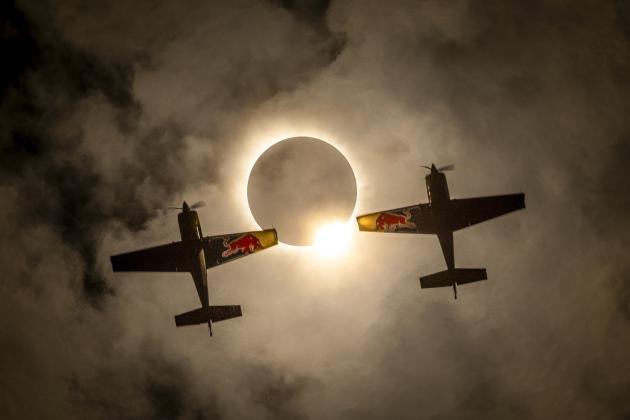| Red Bull Challenge
Two pilots took full advantage of the longest and most visible eclipse for the U.S. in 100 years.
To celebrate the recent celestial event in North America, Red Bull captured photos to eclipse all others. These once-in-alifetime images required aerobatic pilots Kevin Coleman and Pete Mc-Leod to fly in tandem a mere four feet apart, 1,500 feet in the sky, while renowned photographers Mason Mashon and Dustin Snipes photographed them from the ground.
There is no true analog for a total eclipse for practice and preparation. “Normally, this would be a manageable maneuver. But when you have to fly a few feet wing to wing, navigate the darkness from the eclipse, a flight angle that needs to be perfectly in line with the sun, and only four minutes to take the shot while moving at 180 mph, it makes it incredibly challenging,” said Coleman about the project. “It’s a game of inches - two inches off and we lose the image.”
Capturing the planes amidst the solar eclipse required months of preparation, sorting out details of locations, flight paths, distances, and the means of illuminating a plane in near total darkness. Reflective vinyls were installed on the plane to ensure the wings were visible from the ground.
“This is one of the hardest photos that I’ve ever tried to capture,” said Mashon. “There are known settings to capture an eclipse, but when you need to figure out the height of the planes above ground level to frame and scale them perfectly with the eclipse, during totality, it’s a totally different game.”
To help line up the planes, Red Bull Air Force team member Luke Aikins was the translator on the ground, helping communicate the needed adjustments from the photographers to the pilots in the air.
Snipes added “Communication was key throughout this entire shoot. We were constantly discussing what we wanted the final image to look like, and the best way to get the planes in the perfect position to accomplish it.”
This was an opportunity to take advantage of a rare celestial event, and challenge pilots and photographers in new and unexpected ways. “Unlike the high adrenaline and aerobatics I’m used to, this project is all about exact precision and planning”, said Mc-Leod. “It’s all about teamwork to make this happen so it’s been incredible to be a part of.'


